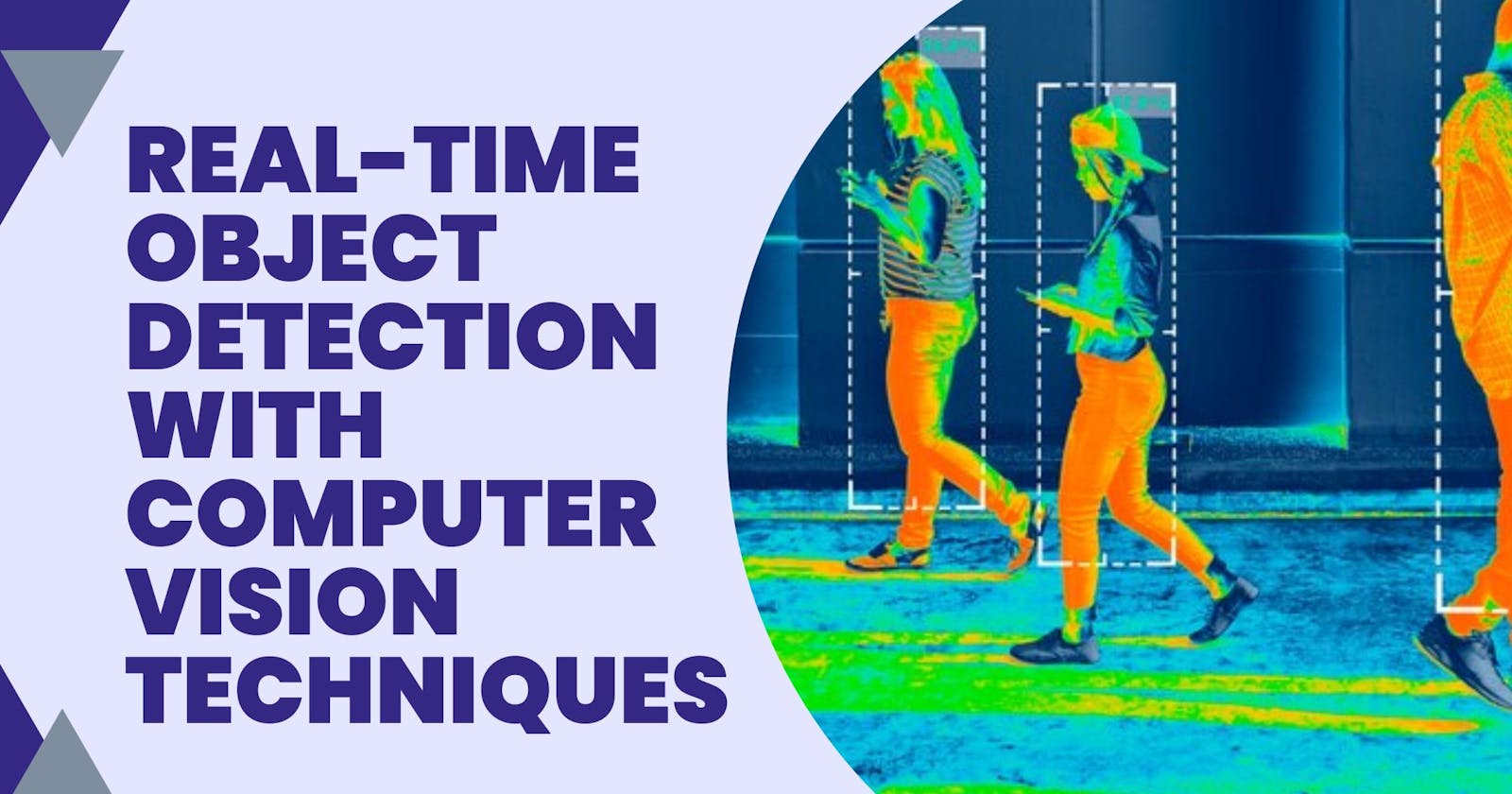Real-time Object Detection with Computer Vision Techniques
Let's discover the fascinating area of computer vision, known as Object detection, where algorithms allow machines to instantly recognize things.
Table of contents
Introduction
Have you ever imagined a world where your camera not only captures the beauty of a landscape but also recognizes the objects within it in real-time? Imagine the possibilities: vehicles that can drive themselves through traffic, security systems that can quickly recognize intruders, and medical equipment that can instantaneously diagnose illnesses. This is the magic of "Real-time Object Detection." The fascinating area of computer vision solutions, where algorithms and neural networks allow machines to instantly recognize and find things inside photos and movies, will be discussed in this blog. Object detection is crucial in many fields, from advancing security systems to revolutionizing healthcare.
Understanding Object Detection
Object Detection:
Imagine you're looking at a photo, and you want to not only know what's in the picture but also exactly where each object is located and draw a box around it. That's essentially what object recognition does in the world of computers and artificial intelligence.
Significance in Computer Vision:
Object detection is like the superhero of computer vision services. It is essential because it enables computers to comprehend the visual world in a manner similar to how people do. This technology can be used in various applications:
1. Autonomous Vehicles: It helps self-driving cars detect other cars, pedestrians, and obstacles on the road.
2. Security: Surveillance cameras use it to identify intruders or suspicious activities.
3. Medical Imaging: It can locate and identify abnormalities in medical images like X-rays or MRIs.
4. Retail: In retail stores, it can track inventory and identify shoplifters.
5. Augmented Reality: It enables AR apps to recognize objects in the real world and overlay digital information on them.
Difference from Image Classification:
Image classification is like looking at a photo and saying, "This is a cat" or "This is a dog." It assigns a single label to an entire image. Object detection, on the other hand, not only tells you what's in the image but also precisely where each object is and draws a box around it. So, in a picture with both a cat and a dog, object recognition can say, "There's a cat here, and there's a dog there."
Difference from Image Segmentation:
Image segmentation takes things a step further. It doesn't just put a box around objects; it actually colors each pixel in the image to show which object it belongs to. Imagine you have a picture of a person holding an apple. Object recognition would say, "There's a person and an apple," but segmentation would color every pixel in the person one way and every pixel in the apple another way, so you could see their exact shapes.
Computer Vision Techniques for Object Detection
1. Convolutional Neural Networks (CNNs):
Overview: CNNs are the backbone of many object recognition systems. These deep learning models were created particularly to handle grid-like input, such as images.
In order to automatically learn hierarchical features from pictures, CNNs employ convolutional layers. This technique makes them highly effective at detecting patterns and details for object recognition.
Strengths: CNNs excel at feature extraction, allowing them to capture intricate visual information from images. They are the foundation for many modern object recognition architectures.
When to Use: CNNs are typically used in conjunction with other object recognition techniques, forming the basis for feature extraction in more complex models like Faster R-CNN and YOLO.
2. Region Proposal Networks (RPNs):
Overview: RPNs are part of the Faster R-CNN architecture. They are responsible for generating region proposals (potential bounding box locations) within an image. RPNs use anchor boxes and a binary classifier to suggest where objects might be located.
Strengths: RPNs are efficient at proposing candidate object locations, which reduces the search space for object detection. They help improve accuracy and speed in recognition tasks.
When to Use: RPNs are an integral part of Faster R-CNN and its variants. They are suitable for scenarios where precise object localization is required.
3. Single Shot MultiBox Detector (SSD):
Overview: SSD is a real-time object recognition framework that combines feature maps from multiple scales to predict object classes and bounding box offsets simultaneously. It uses default anchor boxes at different aspect ratios to detect objects at various scales.
Strengths: SSD is known for its speed and accuracy, making it suitable for real-time applications. It handles objects at different scales effectively due to its multi-scale feature fusion.
When to Use: SSD is ideal for scenarios requiring real-time detection, such as autonomous vehicles or video analysis.
Tools and Frameworks
Popular tools and frameworks like TensorFlow, PyTorch, and OpenCV are widely used for real-time object recognition. Here's an overview of each of these tools and some resources for implementing object detection with them:
TensorFlow:
Description: TensorFlow is an open-source deep learning framework developed by Google. It offers a variety of machine learning techniques and frameworks, including object recognition.
Object Detection Library: TensorFlow has a dedicated library called TensorFlow Object Detection API that simplifies the process of training and deploying detection models. It supports various pre-trained models and is highly customizable.
PyTorch:
Description: PyTorch is another popular open-source deep learning framework developed by Facebook's AI Research lab. It's known for its flexibility and dynamic computation graph.
Object Detection Libraries: PyTorch has several object detection libraries and pre-trained models available. Detectron2 is one of the most widely used libraries for detection in PyTorch.
OpenCV:
Description: OpenCV (Open Source Computer Vision Library) is a popular open-source computer vision library that provides various tools for image and video processing, including object recognition.
Haar Cascades: OpenCV includes support for Haar Cascades, a simple but effective detection technique. It's particularly useful for real-time face detection and other simple object recognition tasks.
YOLO (You Only Look Once):
Description: YOLO is an efficient real-time object detection algorithm that has been implemented in various deep learning frameworks, including TensorFlow and PyTorch.
MXNet:
Description: MXNet is another deep learning framework known for its efficiency and scalability. It also provides tools for real-time detection.
GluonCV: GluonCV is a computer vision toolkit built on top of MXNet, providing pre-trained models and utilities.
To accommodate various use cases and preferences, these tools and frameworks offer a variety of alternatives for performing real-time detection. Depending on your specific project requirements and familiarity with these tools, you can choose the one that best suits your needs. Be sure to refer to the official documentation and tutorials for each tool/framework for detailed guidance on implementation.
Conclusion:
In conclusion, real-time object detection using computer vision techniques has emerged as a transformative field with immense potential. It has revolutionized various industries, from autonomous vehicles and surveillance systems to healthcare and retail. The ability to swiftly and accurately identify objects in a live video stream has paved the way for innovative applications that enhance safety, efficiency, and convenience.
As technology continues to advance, we can anticipate even more sophisticated object detection systems that offer improved accuracy and real-time performance. However, challenges like scalability, real-world variability, and ethical considerations remain. It is crucial to strike a balance between technological progress and responsible usage to ensure that these systems benefit society as a whole.
In the coming years, we can look forward to exciting developments in real-time object detection, making our world smarter, safer, and more connected.

